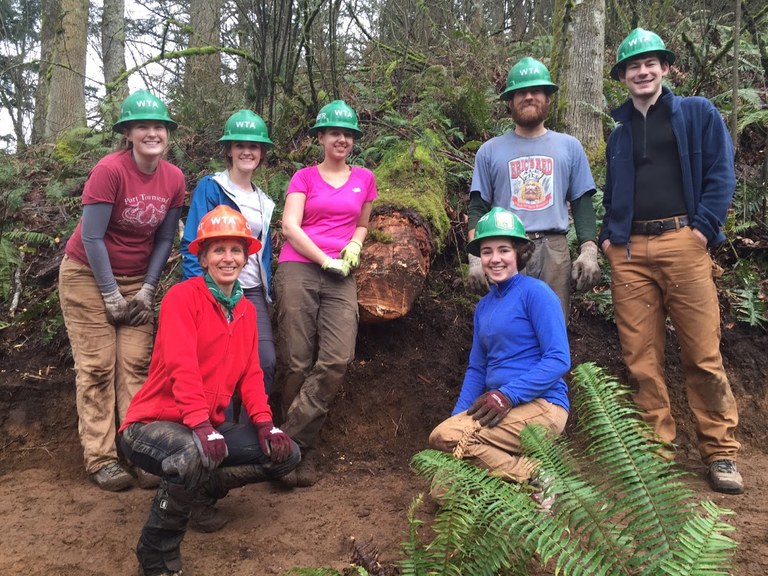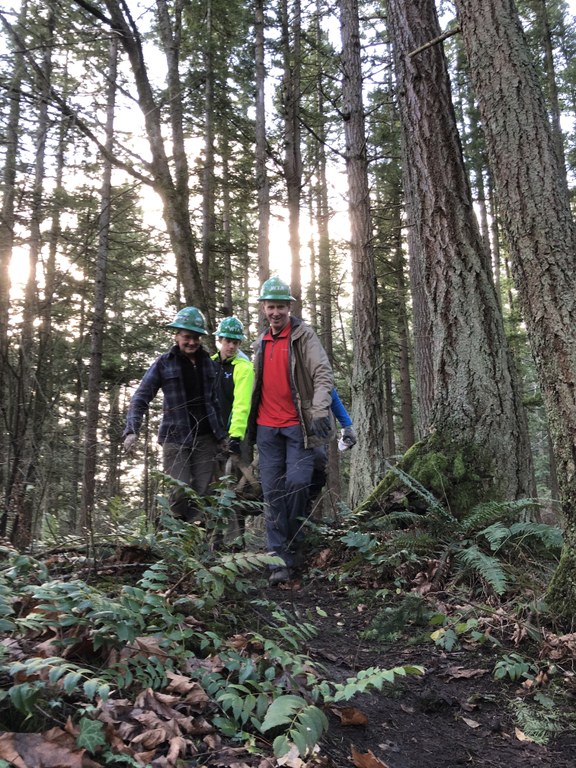Centering Community Helped Build a Strong Urban Trail System in Bellingham
Fourteen years of work by WTA and our partners have transformed an urban trail system in Bellingham.
By Krista Dooley
In Bellingham, the Sehome Arboretum is tucked in between neighborhoods, Sehome High School and Western Washington University. A network of trails meanders through this urban greenspace, creating an accessible nature experience for thousands of college students and city dwellers. The trails also provide commuter routes to Western from nearby housing. Locals bring out-of-town guests to experience the solitude and explore the unique geology of the arboretum.
The Sehome Arboretum is an example of the power of partnership, as well as the immense value of having easily accessible trails in urban areas. For 14 years, WTA has been working on projects in the arboretum and the work has created a stronger trail system while giving students and volunteers a chance to connect to the natural world and learn new skills. Most recently, after working on it since 2013, WTA crews, including Western staff and alumni, have finished up work on the Elderberry Trail, which connects the entire east side of the arboretum.

Volunteers smile on a section of trail at Sehome Arboretum. Photo by Mike Bellis.
Work in the arboretum began way back in the spring of 2007, when a high school English teacher, the head of facilities at Western Washington University, the Bellingham REI’s outreach specialist and WTA’s new youth program coordinator sat at desks in a Sehome High School classroom to discuss project goals, a timeline, funding and trail layout — all with the vision of having teens do volunteer trail work at the Sehome Arboretum, a greenspace adjacent to the school, in late October of that year for Make a Difference Day, a Whatcom County community event.
The idea was to start planning in the spring with high school juniors, who in the fall would be seniors, to build a new trail in the greenspace. The project would engage the community and improve access from the local neighborhood to the existing trail network.
The 7-month planning process was a success, and it was the start of the Sehome Hill Legacy Project. By that October, a small, dedicated group of Sehome High School students had helped lay out the trail, learned how to use hand tools to rough in a new trail, designed a poster to promote the community event and recruited volunteers to join in. Forty-three volunteers participated in the 2007 Make a Difference Day work party at the Sehome Arboretum which made a huge impact to create more trails to open access to the urban oasis.

Building connections
In the 14 years since, WTA has hosted more than 60 work parties in the arboretum and continued to collaborate with WWU, the City of Bellingham, REI and Whatcom Volunteer Center. The work began as a high school project and it’s kept growing to welcome more of the community. The area is used heavily by locals — especially students at Western.
Many groups have also had the chance to work in the arboretum as well. It’s a powerful way for WTA to build connections in the community and with local organizations. For instance, we’ve teamed up for several events with REI and the City of Bellingham, most notably an Eagle Scout project that finished the Allen Street trail connection to the college campus.
In addition, the arboretum is regularly used as an outdoor learning classroom. In 2013, WWU student and WTA crew leader Jackson Lee started the Western Wilderness Trail Corps (WWTC) as part of a senior thesis project. The idea was to introduce students to trail work and connect with others who share common interests in the outdoors. The group leaders also learned how to navigate working with land management (the arboretum board and City of Bellingham) to design a new trail.
Jackson said the WWTC was able to bring people together around a special place. “It’s a great gift to have local spaces and make connections to people and the spaces too,” he said.
The WWTC was designed so that as leaders graduated, other folks were able to keep the group going. Venice Wong (who also has been a WTA crew leader) took over from Jackson after he graduated. WTA’s collaboration with WWTC lasted through 2017.
Jackson, now the stewardship coordinator for Kitsap County Parks Department, recently reflected on the benefits of having the arboretum near campus.

Volunteers enjoying a lunch break while working at Sehome Arboretum.
“As a student, when I was stressed, it was a great space to go for a walk to decompress, Jackson said. “The greenspace’s location allows students living on campus access to nature right from the dorms, with no transportation barriers.”
And the close proximity work parties gave college-age volunteers the opportunity to work together while experiencing the satisfaction of the tangible results of building a trail for others to use and benefit from for years to come. It also opened up work parties to people who might not have attended in a different location.
“I most certainly saw a different mix of volunteers than might not otherwise make the journey to the ‘big mountains’. These new faces found a connection with WTA that might otherwise have been missed,” said Mike Bellis, a Bellingham-based volunteer crew leader who has led many work parties in the arboretum. “The trails and quiet spaces within this forest allow for a quick get-away from urban life. It also provides a visual anchor point in the Bellingham city scape. Whether approaching from the north or south, the Sehome arboretum rises up from the urban landscape to remind visitors and residents that forests are an integral part of why we live in this city.”

An engaged community
In addition to folks who use the trails every day, businesses like local REI stores see the value of urban trails to connect communities, and the support of businesses can help make more work possible. In 2007, the Bellingham REI awarded a $5,000 community grant to support the Sehome work. When announcing the funding award, REI said, “We are looking forward to working with you all as we move forward to create a lasting trail system and a wonderful community resource, and help students learn the values of the important work to be done in our community.”
Arlen Bogaards, WTA’s northwest regional manager, has been coordinating and leading WTA volunteer work parties in the arboretum for over a decade. He recently reflected on the experience.
“Working in the arboretum has been rewarding,” Arlen said, “as I’ve gotten to know and build lasting relationships with partners, agency folks, board members, students and faculty — and not just improve trail opportunities but build lasting community.”
The success of this project over the years is a powerful example of what can be accomplished in an urban area when the community is excited and engaged. And we’re excited to see more similar success around the state with our Trail Next Door campaign, which focuses on trails that are easily accessed from urban area. Because we believe that nature should always be in reach.


Comments